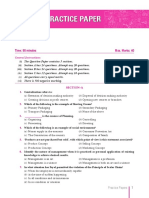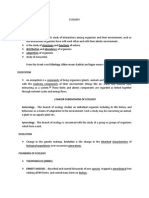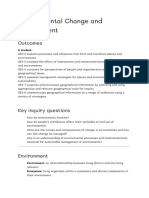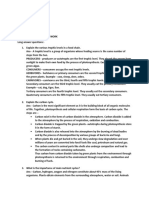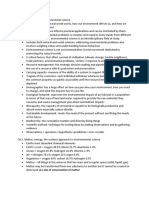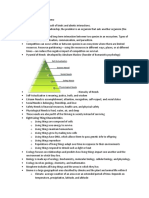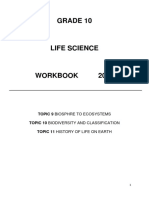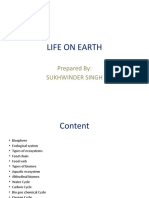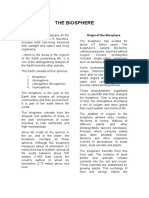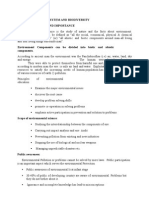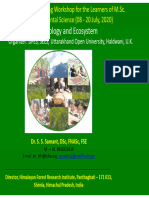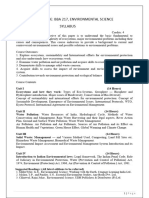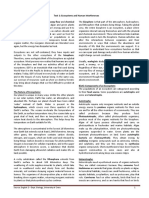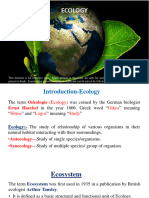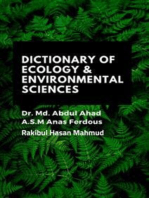0 ratings0% found this document useful (0 votes)
1 viewsReviewer-EnviSci
Reviewer-EnviSci
Uploaded by
dariajohncarlo02Reviewer on environmental science
Copyright:
© All Rights Reserved
Available Formats
Download as DOCX, PDF, TXT or read online from Scribd
Reviewer-EnviSci
Reviewer-EnviSci
Uploaded by
dariajohncarlo020 ratings0% found this document useful (0 votes)
1 views3 pagesReviewer on environmental science
Copyright
© © All Rights Reserved
Available Formats
DOCX, PDF, TXT or read online from Scribd
Share this document
Did you find this document useful?
Is this content inappropriate?
Reviewer on environmental science
Copyright:
© All Rights Reserved
Available Formats
Download as DOCX, PDF, TXT or read online from Scribd
Download as docx, pdf, or txt
0 ratings0% found this document useful (0 votes)
1 views3 pagesReviewer-EnviSci
Reviewer-EnviSci
Uploaded by
dariajohncarlo02Reviewer on environmental science
Copyright:
© All Rights Reserved
Available Formats
Download as DOCX, PDF, TXT or read online from Scribd
Download as docx, pdf, or txt
You are on page 1of 3
ENVI SCI John Xavier Manglicmot 7 environmental principles;
1. All life forms are important.
CHAPTER 1: 2. Everything is connected to everything else.
Science - way of life which uses systematic procedures 3. Everything must go somewhere.
to obtain facts based on observation, investigation and 4. Ours is a finite earth.
experimentation; is an organized body of knowledge 5. Nature knows best.
that deals with careful observation and interpretation 6. Nature is beautiful and we are stewards of God’s
of reproducible facts. creation.
Scientific method - make use of science process to 7. Everything Changes.
gather information and establish facts about a certain
problem. Sustainable Development - process of change by which
make use of science process to gather information and the exploitation of resources, the direction and
establish facts about a certain problem. investments, the orientation of technological
Science Process - include observing, inferring, development and institutional changes are made
measuring and controlling variables, as well as responsive too future and as well as present needs.
analyzing and interpreting data.
Environment - the condition that surround an organism
or group of organisms. CHAPTER 2:
Environmental Science - study of life and the method of Biotic Structure - An assemblage of organisms in a
sustaining it on Planet Earth. prescribed physical habitat. A diversity of species
Ecology - discipline of biology that studies the usually occupies an area sharing resources and
interrelationships between organisms and their competing on other factors.
environment and basic tool of environmental science. Producer - Autotrophic organisms that make their own
Atmospheric Science - includes the study of weather food.
and climate greenhouse and other airborne pollutants. Phototrophic - plants use light energy from the sun to
Environmental Chemistry - examines chemicals in the covert carbon dioxide (from the atmosphere) and water
environment including air, soil, and water pollution. (from the soil) to a sugar called starch and release
Environmental Geology - study of soil erosion, oxygen as a byproduct.
groundwater use, ocean pollution and climate. Photosysnthesis - The process of chemical conversion
Environmental Scientist - they study the physical, by light energy.
chemical and biological conditions of the environment Chemothropic - organisms use chemicals other than
and how these conditions impact organisms. H20, such as H2S.
Environmentalist - advocates for the environment. Consumers - organisms that cannot produce their own
Ethics - branch of philosophy that is concerned with food but must feed on other organisms in order to
morals and values. obtain energy and nutrients.
Morals - the distinction between right and wrong. Primary Consumers (Herbivores) - animals that feed
Values - the ultimate worth of action. directly on producers.
Environmental Ethics - the moral relationship between Secondary Consumers (Carnivores) - Animals that feed
humans and the natural world; the foundation of on primary consumers.
sustainable society. Tertiary Consumers (Omnivores) - Animals that have
Ecocentric - nature centered. mixed diets that includes both plants and animals.
Anthropocentric - people centered. Detritus Feeders and Decomposers - organisms that
Conservation - using the resources more efficiently. feed on the dead and break down their complex
Recycling - to use material again and again. substances to simpler forms and return these
Renewable Resources - resources that are generated by substances to the abiotic environment. e.g. earthworms
natural process.
Non-renewable Resources - resources that will deplete Abiotic Structure - The abiotic environment is a habitat
over a lifetime, consumed at a rate faster than they can with specific and complex sets of non-living factors
naturally reproduced. affecting life of the organism. E.g. soil, water, light, air,
Population Control - stabilization and eventually temp, topography
reduction of the size of human population. Topography - physical feature of habitat.
“The main agenda of the Earth Summit 1922 is to Biochemical Cycles - Inorganic nutrients cycle trough
reconcile the worldwide economic development with more than organisms, but they can also enter into the
protection of the environment, the purpose of the atmosphere, the oceans, and even rocks.
conference was to rethink economic growth advance Reservoires - are those parts of the cycle where the
social equity and to ensure environmental protection.” chemical is held in large quantities for long periods of
time.
Exchange Pools - the chemical is held for only a short Biomes - large-scale category containing many
period of time. communities of a similar nature, whose distribution is
Residence Time - The length of time a chemical is held largely controlled by climate.
in exchange pool or a reservoir is termed.
The Water Cycle - consists of evaporation, condensation Terrestrial Ecosystem;
and precipitation. Praire or Grassland - deep fertile soil with covering of
Carbon Cycle - movement of carbon in elemental and tall coarse grasses.
combined states on earth. Desert - an uninhabited and uncultivated tract of land.
Oxygen Cycle - closely related to the carbon cycle. It is desolate, barren, waterless and treeless region of
Molecular oxygen is continuously produced by the earth,
process of photosynthesis and by photo-dissociation of Tropical Forest - large tract of land covered with trees
water. oxidation process continuously withdraw oxygen and undergrowth, sometimes intermingled with nature.
from the atmospheric pool. Tundra - snow and ice and on the tree, line lies the flat,
Nitrogen Cycle - The main reservoir of nitrogen is the air marshy land. Only mosses and low plants grow.
which is about 78% nitrogen gas. Plants cannot utilize Savannah - very hot day and a very cold night, it is life
nitrogen gas directly from the air; instead, the nitrogen an enormous meadow.
must be in a mineral form, such as ammonium ion Temperate Deciduous Forest - has winter-summer
(NH4+) or nitrate ion (NO3-1). change seasons, typically have trees that lose their
Biological Nitrogen Fixation - A number of bacteria and leaves during the winter and replace them the following
also certain blue-green algae, which are actually spring.
bacteria can convert nitrogen gas to the ammonium. Taiga - noted for its great stands of spruce, fir,
Fixed organic nitrogen is passed from the plants to needlelike leaves that can withstand the weight of
other organisms in the ecosystem through food chain. accumulated snow.
Denitrifying Bacteria - As animals break down, protein
and other organic compounds containing nitrogen gas. Fresh water ecosystem – those that have little dissolved
Atmospheric Nitrogen Fixation - Some nitrogen gas is salt
converted to the ammonium form by lightening. Marine water ecosystem – those that have a high salt
Phosphorus Cycle - Phosphorus exists in various rocks content
and soil minerals as the inorganic phosphate ion (PO4- Pelagic - an open ocean with animals such as
3). As rock gradually breaks down, phosphate and other crustaceans, fish and whales swim actively as they
nutrient ions are released. Phosphate dissolved in pursue food.
water but does nor enter air. Euphotic Zone - region where the sun’s ray penetrates.
Zooplankton - small, weakly swimming animals of many
2 Laws of thermodynamics kinds that are often located at greater depths in the
1. energy cannot be created or destroyed; it can only be ocean that feed on phytoplankton.
changed from one to another. Benthic - ocean bottom, whether attached or not such
2. whenever energy is transformed, there is loss of as fish, clams, oysters, various crustaceans, sponges,
energy through the release of heat. sea anemones, and many other kinds of organisms live
on the bottom.
The Ten Percent Law - When all of the energy losses are Abyssal - a great depth in the ocean ecosystem that
added together, only about 10% of the energy entering must rely on a continuous rain of organic matter from
one trophic level forms biomass in the next trophic the euphotic zone.
level. Estuaries Ecosystem - special category of marine
ecosystem, consists of shallow, partially enclosed areas
Food Chain - sequence of consumption and represents where freshwater enters the ocean.
energy transfer through the environment. For example, Epilimnion - upper surface layer of a lake. It is warm in
a simple grazing food chain is comprised of summer.
plant herbivore carnivore. Hypolimnion - cold lower layer of a lake.
Food Web - network of food chains representing the Thermocline - A sudden drop in temperature occurs at
feeding relationships among organisms in an the middle of the lake .
ecosystem. Swamps - contain trees that are able to live in places
that are either permanently flooded or flooded for a
Terrestrial (Land), Aquatic (Water) - two basic types of major part of the year.
community contain eight smaller units known as Marshes - are dominated with grasses and reeds.
biomes.
Intraspecific Condition - density-dependent form of
competition.
Interspecific Condition - different individuals competing Demography - applied branch of sociology that deals
over resources. with population statistics and provides information on
the population of various countries or groups of people.
Symbionts - relationships can be beneficial, neutral, or Population Regulation - control of the size of the
harmful to one or both organisms. population. This regulation implies a tendency of the
Obligatory Symbiosis - one or both organisms are population to achieve or return to a size at equilibrium
entirely dependent on the relationship and will die or in harmony with the surrounding environment. If a
without it. population tends to remain about the same size, then it
Facultative Symbiosis - can live independently from is said to be stable.
each other. Overpopulation - condition where an organism’s
Parasitism - relationship where one symbiont benefits number exceed the carrying capacity of its habitat.
(the parasite) and the other (the host) is harmed in On Resources - Many of our basic resources are stained
some way and may eventually die. by the present population. The food we eat, the quality
Commensalism - , one species benefits and there is a of our air, the quality of our water, our oil and gas, and
neutral effect on the other—it neither benefits nor is the ozone layer.
harmed. On Social Problems - Another effect of overpopulation
Mutualism - both organisms benefit from the is its obvious stress placed upon people, especially in
relationship. cities who tend to be less friendly compared to people
in town.
Population - group of individuals of the same inhabiting On Personal Freedom - As the problem of higher
a common area; a collective group of individuals population density becomes worse, there are more and
occupying a particular place at a given time and it is more restrictions on our freedom. These include putting
affected by both biotic and abiotic factors. limits on our water consumption, driving, travel, and
Natality - refers to the individual added to the possibly what people can do for their land.
population through reproduction. On Other Species - What is more alarming is the effect
Mortality - refers to the number of deaths per year. of our present population not only on our species but to
Sex Ratio - refers to the relative numbers of males and other species as well who strike a balance in the
females. biosphere for the continuity of all life on Earth.
Distribution - refers to the arrangement of individuals
of a population within a particular space.
Random Distribution - organisms are spread throughout
the area without an over-all pattern.
Uniform Distribution – the organisms are evenly
distributed over an area.
Clumped Distribution – the organisms are evenly
concentrated in an area. It may offer the population
protection from enemies.
Population Density - refers to the number of organisms
found per unit area.
Open community - structure and the relative rarity of
species within a community.
Closed Community - a discrete unit with sharp
boundaries known as ecotones.
Succession - series of regular, predictable changes in
the structure of a community over time.
Primary succession - is a progressive colonization of a
previously unoccupied area. It occurs on some bare,
lifeless substrate such as rocks or open water where
organisms gradually occupy the area and change its
nature.
Secondary succession - this occurs in areas that have
been disturbed and that were originally occupied by
living organisms, human beings are initiating secondary
succession. This may also occur after a fire has burned
off the area, or after eruption of a volcano.
You might also like
- Blair ICBM Code ResponseDocument2 pagesBlair ICBM Code ResponseDan LamotheNo ratings yet
- RKSingla's BS XII Worksheet2Document10 pagesRKSingla's BS XII Worksheet2ANUJ SHARMANo ratings yet
- Answers MagazineDocument17 pagesAnswers MagazineBrenda ShakarianNo ratings yet
- Social EnvironmentDocument3 pagesSocial EnvironmentMary Jane AndesNo ratings yet
- Handouts Ngec 9Document12 pagesHandouts Ngec 9Salvie Perez UtanaNo ratings yet
- NOTESDocument8 pagesNOTESherald reyesNo ratings yet
- Environment and Ecology Notes Unit 2Document25 pagesEnvironment and Ecology Notes Unit 2divyanshu potaliyaNo ratings yet
- ECOLOGYDocument160 pagesECOLOGYmichelle banacNo ratings yet
- ReviewerDocument7 pagesReviewerTristan BaceraNo ratings yet
- Https - WWW - Cambridgecsd.org - Site - Handlers - Filedownload - Ashx - Moduleinstanceid 106&dataid 976&FileName Ecological Systems PDFDocument23 pagesHttps - WWW - Cambridgecsd.org - Site - Handlers - Filedownload - Ashx - Moduleinstanceid 106&dataid 976&FileName Ecological Systems PDFdipon deb nathNo ratings yet
- Environmental Engineering Chapter 1 For PrintDocument17 pagesEnvironmental Engineering Chapter 1 For PrintMike ian MercadoNo ratings yet
- Eco Shit ReviewerDocument15 pagesEco Shit ReviewerCharlaine OrenciaNo ratings yet
- EcosystemDocument47 pagesEcosystemRose Belle A. GarciaNo ratings yet
- Geography Year 10 NotesDocument34 pagesGeography Year 10 Notesanushka.deore242No ratings yet
- MST1 MidtermsDocument15 pagesMST1 MidtermsJam DomingoNo ratings yet
- Ecosystem and Biogeochemical ChangesDocument10 pagesEcosystem and Biogeochemical ChangesgenieNo ratings yet
- Reviewer in Environmental ScienceDocument5 pagesReviewer in Environmental ScienceCaloys kiNo ratings yet
- Topic 2 EcologyDocument10 pagesTopic 2 EcologyJomari TawatNo ratings yet
- General EcologyDocument4 pagesGeneral EcologyCiarraNo ratings yet
- Cls 9 EVS Mod 2 On How Ecosystems WorkDocument4 pagesCls 9 EVS Mod 2 On How Ecosystems WorkItu DeyNo ratings yet
- EcosystemDocument7 pagesEcosystemHamza Khan100% (1)
- DSE Bio Notes CH 21 26 27 28Document73 pagesDSE Bio Notes CH 21 26 27 28chingNo ratings yet
- Ecosystem Structures and Processes - NewDocument77 pagesEcosystem Structures and Processes - NewglennNo ratings yet
- Introduction To Environmental ScienceDocument5 pagesIntroduction To Environmental ScienceCody FrancisNo ratings yet
- AP Environmental Science NotesDocument131 pagesAP Environmental Science NotesAkshay BalaNo ratings yet
- Evs Unit 1Document24 pagesEvs Unit 1Joy BhowmickNo ratings yet
- Atmosphere: LithosphereDocument6 pagesAtmosphere: LithosphereNandini TariyalNo ratings yet
- People and Earth'S Ecosystem: Topic 2: Ecosystem Structure & FunctionDocument54 pagesPeople and Earth'S Ecosystem: Topic 2: Ecosystem Structure & FunctionMind ControlNo ratings yet
- Grade 10 Ls Workbook 2021Document31 pagesGrade 10 Ls Workbook 2021Mabontle BusangNo ratings yet
- Ecological and Environmental SciencesDocument16 pagesEcological and Environmental Sciencesmelvin.a.casingalNo ratings yet
- An Overview of EcologyDocument37 pagesAn Overview of EcologyKeizent Rose MarquezNo ratings yet
- 2004 Biology Notes LeoDocument8 pages2004 Biology Notes LeoEliza HeartNo ratings yet
- ENVISAFE - (2) Ecology of LifeDocument42 pagesENVISAFE - (2) Ecology of LifeRenz Delacruz GuiaoNo ratings yet
- Life On Earth: Prepared By: Sukhwinder SinghDocument17 pagesLife On Earth: Prepared By: Sukhwinder SinghSukhvinder Singh SinghNo ratings yet
- Module 3 PDFDocument40 pagesModule 3 PDFTejaswi SinghNo ratings yet
- Unit 3 Ecosystems Upto BiogeochemicalDocument141 pagesUnit 3 Ecosystems Upto Biogeochemicalmdnaushadansari72786No ratings yet
- 14 EcosystemDocument31 pages14 Ecosystemjerifaa87No ratings yet
- EcologyDocument2 pagesEcologyせん 知りNo ratings yet
- EcosystemDocument5 pagesEcosystemRaine CuenarNo ratings yet
- Ensci NotesDocument7 pagesEnsci NotesJen PedrosaNo ratings yet
- Environmental Science and Engineering Lecture Notes EDITEDDocument107 pagesEnvironmental Science and Engineering Lecture Notes EDITEDSrikanth PalaniswamyNo ratings yet
- Topic 1 - Environmental SciencesDocument32 pagesTopic 1 - Environmental SciencesJomari TawatNo ratings yet
- Our EnvironmentDocument9 pagesOur Environmentraimaali220077No ratings yet
- Evs Module-1.2Document26 pagesEvs Module-1.2HamsaNo ratings yet
- Principles of EcologyDocument44 pagesPrinciples of EcologyGiancarlo SantosNo ratings yet
- Environment, Ecosystem and Biodiversity Definition, Scope and ImportanceDocument90 pagesEnvironment, Ecosystem and Biodiversity Definition, Scope and Importancehakkem bNo ratings yet
- Environment and Ecology: Environmental Studies, I/Ii Sem B.E.-Vtu Unit 1 & 2Document15 pagesEnvironment and Ecology: Environmental Studies, I/Ii Sem B.E.-Vtu Unit 1 & 2Praful KakdeNo ratings yet
- Ecological TermsDocument9 pagesEcological Termsdrjgkpathan5866No ratings yet
- Ecological Concepts and Principles: TTH 5 - 6:30 PM 7 - 8:30 PM 2 Semester AY: 2018 - 2019Document76 pagesEcological Concepts and Principles: TTH 5 - 6:30 PM 7 - 8:30 PM 2 Semester AY: 2018 - 2019Reggie PalaganasNo ratings yet
- 7.1 Ecosystem 1Document58 pages7.1 Ecosystem 1Budi Sigit PurwonoNo ratings yet
- Ecology and Ecosystems I - Dr. S.S. SamantDocument26 pagesEcology and Ecosystems I - Dr. S.S. Samantbirudulavinod1No ratings yet
- EVS Notes, Unit 4, B.tech RUDocument21 pagesEVS Notes, Unit 4, B.tech RUSumukha BhoganathamNo ratings yet
- People and Environment1Document72 pagesPeople and Environment12046 Karthick RajaNo ratings yet
- GE3451Document65 pagesGE3451Everbloom EverbloomNo ratings yet
- Ge 15 Reviewer 1 3Document5 pagesGe 15 Reviewer 1 3LORRAINE ANNE LAURENTENo ratings yet
- Environmental Studies-1Document51 pagesEnvironmental Studies-1Muskan NarulaNo ratings yet
- Synopsis ENVIRONMENTAL SCIENCE PAPER CODE 217Document69 pagesSynopsis ENVIRONMENTAL SCIENCE PAPER CODE 217Swati MauryaNo ratings yet
- Ge Elec 1 Prelim Reviewer: Module 1: Introduction To Ecosystem ECOSYSTEM First Appeared in ADocument11 pagesGe Elec 1 Prelim Reviewer: Module 1: Introduction To Ecosystem ECOSYSTEM First Appeared in AJade PaulosNo ratings yet
- Week 2 - Text 1. Ecosystems and Human InterferencesDocument2 pagesWeek 2 - Text 1. Ecosystems and Human Interferences458 269 Cinta Alivia AthaNo ratings yet
- 13-14 CH 3 Instructor ManualDocument10 pages13-14 CH 3 Instructor ManualjdawgeeeeNo ratings yet
- Unit 2 ECOLOGYDocument42 pagesUnit 2 ECOLOGYmalikanuj0151No ratings yet
- Dictionary Of Ecology & Environmental Sciences: A book by Rakibul Hasan MahmudFrom EverandDictionary Of Ecology & Environmental Sciences: A book by Rakibul Hasan MahmudNo ratings yet
- SFR Motorcycle Chain ENDocument7 pagesSFR Motorcycle Chain ENjavierhonda69gmail.comNo ratings yet
- Maximum Linux Security (2nd Edition)Document895 pagesMaximum Linux Security (2nd Edition)Marcus Diniz100% (3)
- Python - Making A Fast Port Scanner - Stack OverflowDocument8 pagesPython - Making A Fast Port Scanner - Stack OverflowSup' Tan'No ratings yet
- Eriksen PDFDocument12 pagesEriksen PDFBruno DelalunaNo ratings yet
- Saint Columban College: Item and Statitical Analysis of Computer 10 in Assessment in Learning 2Document6 pagesSaint Columban College: Item and Statitical Analysis of Computer 10 in Assessment in Learning 2Crystal Ann Monsale TadiamonNo ratings yet
- Summative Test in Science 10 Mod 5Document4 pagesSummative Test in Science 10 Mod 5Ruth Anne BarriosNo ratings yet
- The Medieval Attitude Toward AstrologyDocument179 pagesThe Medieval Attitude Toward AstrologyAbhi AbhijithNo ratings yet
- Bruce E. Depalma: N-Machine: Extraction of Electrical Energy Directly From Space: The N-MachineDocument7 pagesBruce E. Depalma: N-Machine: Extraction of Electrical Energy Directly From Space: The N-MachinebanzailoicNo ratings yet
- Cma Pac Labor Costing Test QPDocument1 pageCma Pac Labor Costing Test QPJAMES RATHERNo ratings yet
- 395 PDSDocument2 pages395 PDSNorman Mokoginta,ST,MBANo ratings yet
- Nugraha Mauluddin CV UpdateDocument4 pagesNugraha Mauluddin CV UpdateNugraha MauluddinNo ratings yet
- Physical and Antimicrobial Properties of Banana Flour and Chitosan BiodegradableDocument6 pagesPhysical and Antimicrobial Properties of Banana Flour and Chitosan BiodegradableLC7040861No ratings yet
- Bsba Midterm ExamDocument2 pagesBsba Midterm ExamDianne De VillaNo ratings yet
- Mcv4ub Unit2 Parul MarkedDocument21 pagesMcv4ub Unit2 Parul MarkedKaran RaghuvanshiNo ratings yet
- Alcazar, Juvy Rose: 423 Partida Norzagaray Bulacan Cell Number:09065936659 E-Mail AddressDocument15 pagesAlcazar, Juvy Rose: 423 Partida Norzagaray Bulacan Cell Number:09065936659 E-Mail AddressT VinassaurNo ratings yet
- Making Things Talk (PDFDrive)Document496 pagesMaking Things Talk (PDFDrive)Wallie BillingsleyNo ratings yet
- Normal Distribution StatisticsDocument18 pagesNormal Distribution StatisticsNOMAN SHEHZADNo ratings yet
- Periodic Table MCQ-Answer OnlyDocument14 pagesPeriodic Table MCQ-Answer OnlylionelkenethNo ratings yet
- 01 AMRO Course Overview (AHS) 2022 Revd 010222Document7 pages01 AMRO Course Overview (AHS) 2022 Revd 010222mije afiqNo ratings yet
- Most Used Computer & Internet Related Terms, AbbreviationsDocument33 pagesMost Used Computer & Internet Related Terms, Abbreviationsyash patilNo ratings yet
- Acoustic Barrier For Outdoor Music Event: The "Roda de Samba" in Rio de JaneiroDocument10 pagesAcoustic Barrier For Outdoor Music Event: The "Roda de Samba" in Rio de JaneiroNayara GevúNo ratings yet
- The EGGbees by Olivia Echeverria-BisDocument34 pagesThe EGGbees by Olivia Echeverria-BisArte Público PressNo ratings yet
- Chapter 8Document6 pagesChapter 8Jenny LagundayNo ratings yet
- Storyboards Movie Storyboard and What Is A Storyboard ArtistDocument8 pagesStoryboards Movie Storyboard and What Is A Storyboard ArtistUjjal BastakotiNo ratings yet
- How To Calculate The Quantity of Steel Spirals in A Steel Cage of A PileDocument2 pagesHow To Calculate The Quantity of Steel Spirals in A Steel Cage of A PileRajaKuppanNo ratings yet
- Dynamic Capabilities and Managing Human CapitalDocument15 pagesDynamic Capabilities and Managing Human CapitalJason29No ratings yet

